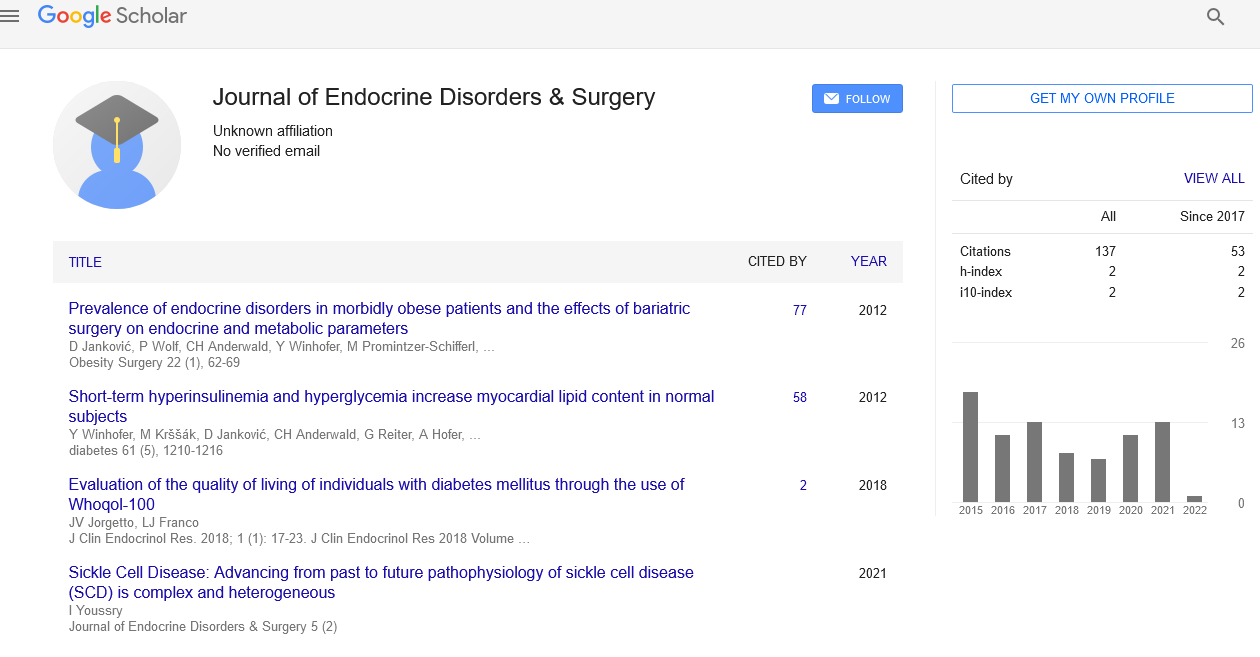Treatment and prevention of adult patients' adrenal crises
Received: 17-Jun-2022, Manuscript No. o PULJEDS-22-5079; Editor assigned: 19-Jun-2022, Pre QC No. PULJEDS-22-5079(PQ); Accepted Date: Jul 02, 2022; Reviewed: 25-Jun-2022 QC No. PULJEDS-22-5079(Q); Revised: 28-Jun-2022, Manuscript No. PULJEDS-22-5079(R); Published: 10-Jul-2022, DOI: 10.37532/puljeds.22.6.(3)20-21
Citation: Yadav V. The impact of functional hypothalamic amenorrhea on women's health. J Endocrine Disorders & Surgery. 2022; 6(3):20-21.
This open-access article is distributed under the terms of the Creative Commons Attribution Non-Commercial License (CC BY-NC) (http://creativecommons.org/licenses/by-nc/4.0/), which permits reuse, distribution and reproduction of the article, provided that the original work is properly cited and the reuse is restricted to noncommercial purposes. For commercial reuse, contact reprints@pulsus.com
Abstract
An abrupt, life-threatening emergency called an adrenal crisis is one of the main causes of the higher than expected death rates seen in people with adrenal insufficiency. Patients with adrenal insufficiency are thought to experience adrenal crises 8 times per 100 patient years. Adrenal crisis patients typically have nonspecific signs and symptoms that result in delayed identification and treatment. These patients report as systemically ill and sick. A patient may experience an adrenal crisis even after being on glucocorticoid replacement medication for some time or it may be the initial sign of adrenal insufficiency. The main triggering reason is infection, but there are other factors as well, such as physical stress after surgery or trauma, forgetting to take glucocorticoid medication, intense physical exercise, and psychological stress. Parenteral hydrocortisone, rehydration, and timely recognition are all c- -omponents of the emergency therapy. Rapid diagnosis, parenteral hydrocortisone delivery, rehydration, and control of electrolyte imbalances are all components of emergency care. Patient education is the key to prevention. Parenteral glucocorticoid therapy and stress dosage should be explained to all patients. They should wear a medical alert bracelet or other form of identification and carry a card alerting others to their steroid dependency. Despite many improvements in the management of patients with adrenal insufficiency, adrenal crisis continues to occur and represents a major source of morbidity, mortality and distress for patients. Improved patient and clinician education and measures to facilitate parenteral hydrocortisone self-administration in impending crisis are central to the management of this life-threatening event.
Key Words
Adrenal Insufficiency; Parenteral Hydrocortisone Delivery; Rehydration
Introduction
Significant morbidity and death are linked to deficiencies of the steroid hormones the adrenal gland produces and secretes. Mineralocorticoids, glucocorticoids, and sex steroids are the three kinds of steroid hormones that the adrenal cortex produces after absorbing precursor cholesterol from the plasma. Aldosterone and deoxycorticosterone are released by the zona glomerulosa in small levels (100 g to 150 g aldosterone/day). The renin–angiotensin– aldosterone system primarily regulates aldosterone production, and its action results in increased sodium absorption in the distal renal tubule after binding to the mineralocorticoid receptor. When stimulated by Adrenocorticotrophic Hormone (ACTH), the Zona fasciculata secretes cortisol and corticosterone in higher levels (10 mg to 15 mg cortisol/day). These glucocorticoids have broad-reaching effects that are mediated by the glucocorticoid receptor. Primary Adrenal Insufficiency (PAI) is a condition in which the adrenal gland itself is unable to function properly. This condition is most frequently brought on by autoimmune-mediated adrenalitis, infections, or an innate disruption of cortisol production in congenital adrenal hyperplasia. Secondary Adrenal Insufficiency (SAI) is brought on by disturbance of the hypothalamic-pituitary-adrenal axis and inadequate stimulation of the adrenal gland as a result of insufficient ACTH production or synthesis.
This is frequently brought on by pituitary disorders, tumours, or the accompanying radiation and surgery needed to cure them. Chronic exogenous glucocorticoid therapy, also known as tertiary adrenal insufficiency, can compromise the pituitary's ability to control cortisol production. Adrenal Insufficiency (AI) is often treated with lifelong glucocorticoid replacement medication. It is essential to distinguish between PAI and SAI because it enables physicians to focus treatment on linked weaknesses. Aldosterone replacement is not necessary because it is regulated by the renin– angiotensin–aldosterone system. In PAI, all steroid hormones produced by the adrenal gland are deficient (aldosterone, cortisol, and sex steroids), whereas in SAI, only those hormones that are primarily controlled by ACTH (cortisol, and sex steroids), are deficient. Although the general therapy of an adrenal crisis is the same for both adult and paediatric patients, the paediatric group has unique difficulties such as greater rates of hypoglycemia, weight-based dosage, and challenging IV access. The treatment and avoidance of adrenal crises in adult patients are the main topics of this study.
AI mortality and morbidity
It is becoming more and clearer that there is considerable morbidity and a shorter life expectancy even in people with treated AI. The leading causes of mortality in individuals with AI were cardiovascular disease (35%) and infection (15%), according to recent data from the European Adrenal Insufficiency Registry (covering both PAI and SAI patients). This finding supports earlier registry data for patients with PAI. According to the EU-AIRE research, individuals with SAI had a death rate of 1.5% adrenal crises per 100 patient years were observed in those SAI patients who passed away, which is considerably more than in other cohorts of SAI patients. Additionally, patients with SAI who passed away were taking higher average daily doses of hydrocortisone (24.0 mg, 7.6 mg versus 19.3 mg, 5.7 mg, p = 0.002), which may have been a result of the doctor's response to frequent adrenal crises by prescribing higher doses of glucocorticoid therapy in an effort to stop the crises from recurring. In undetected AI, an adrenal crisis frequently makes its initial appearance.
Conclusions
Although there has been glucocorticoid replacement medication for more than 50 years, adrenal crisis is still a major cause of mortality in individuals with AI. Reducing the frequency of this potentially fatal presentation requires improved patient education with a focus on stress dosage, medical alert detection, and glucocorticoid emergency kits.





